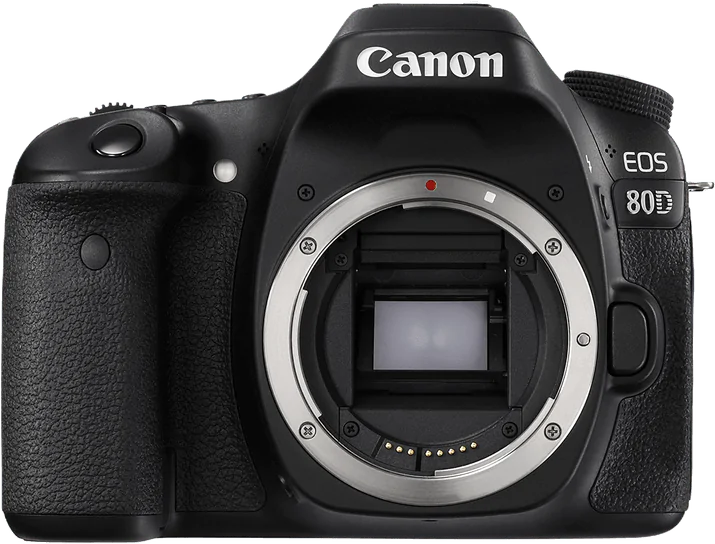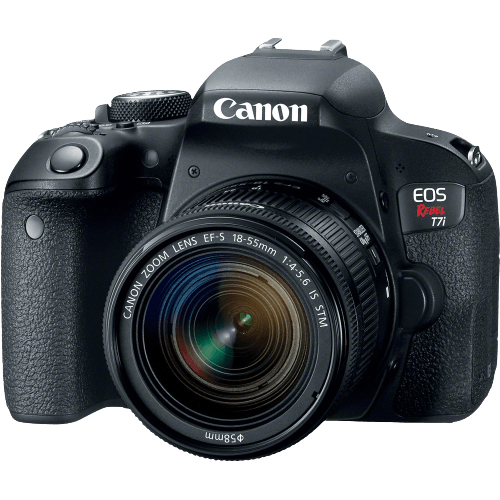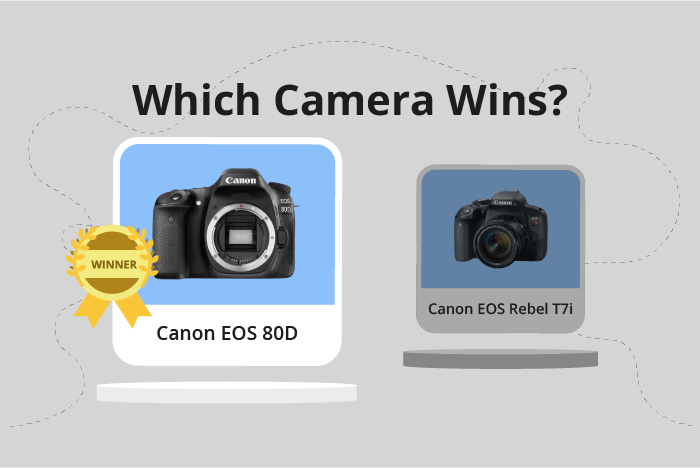Canon EOS 80D vs EOS Rebel T7i / 800D Comparison
Canon EOS 80D

Canon EOS Rebel T7i / 800D

The Canon EOS 80D and Canon EOS Rebel T7i / 800D are both DSLR cameras, each with a score of 64/100. Announced in 2016 and 2017 respectively, these cameras share several specifications. However, the 80D has some advantages, such as a larger size (139 x 105 x 79mm) and heavier weight (730g / 1.61lbs), which may provide a more stable and comfortable grip for some photographers. On the other hand, the T7i / 800D is more compact (131 x 100 x 76mm) and lightweight (532g / 1.17lbs), making it more portable and convenient for travel.
Despite the similarities in scores, each camera caters to different preferences. The 80D is better for those who prefer a more robust build, while the T7i / 800D is ideal for photographers who prioritize portability.
Canon EOS 80D vs EOS Rebel T7i / 800D Overview and Optics
The Canon EOS Rebel T7i / 800D narrowly wins in the optics comparison, scoring 64/100, while the Canon EOS 80D scores 63/100. Both cameras share several specifications, including a CMOS sensor type, APS-C sensor size, and the absence of image stabilization. They also both have a DXOMARK score of 79 for their sensors.
The Canon EOS Rebel T7i / 800D has the advantage of a newer processor, the Digic 7, compared to the Canon EOS 80D’s Digic 6 processor. This updated processor allows for improved image processing and better overall performance. Additionally, the Canon EOS Rebel T7i / 800D has a lens mount that supports both Canon EF and EF-S lenses, providing users with greater flexibility in lens selection.
On the other hand, the Canon EOS 80D has a slightly higher megapixel count at 24.2, compared to the 24 megapixels of the Canon EOS Rebel T7i / 800D. This difference contributes to marginally better image quality and detail in the 80D’s photos. Furthermore, the Canon EOS 80D has a faster shooting speed of 7 frames per second, as opposed to the 6 frames per second offered by the Canon EOS Rebel T7i / 800D, which may be beneficial for capturing fast-moving subjects.
Considering these factors, the Canon EOS Rebel T7i / 800D is the better choice for those looking for a camera with a more advanced processor and broader lens compatibility. However, the Canon EOS 80D remains a strong contender for those who prioritize image quality and shooting speed.
Canon EOS 80D vs EOS Rebel T7i / 800D Video Performance
When comparing the video capabilities of the Canon EOS 80D and the Canon EOS Rebel T7i / 800D, both cameras have a video score of 70/100. This means that their video performance is equal, and there is no clear winner in this category.
Both cameras share the same video specifications, including a maximum video resolution of Full HD, video dimensions of 1920 x 1080, and a maximum video frame rate of 60fps. Additionally, both cameras have built-in time-lapse functionality, making them suitable for capturing stunning time-lapse videos.
As the video scores are equal, there are no specific areas where one camera outperforms the other in terms of video capabilities. Both cameras provide the same level of video quality, making them equally suitable for anyone looking to capture high-quality video footage.
However, it is essential to consider other features and specifications beyond video capabilities when choosing between these two cameras. Each camera may have features that cater to specific needs or preferences that could make one more suitable for a particular user than the other.
In conclusion, both the Canon EOS 80D and the Canon EOS Rebel T7i / 800D have the same video capabilities, with neither camera outperforming the other in this category. Users should consider other aspects and features of each camera to determine which one best fits their needs and preferences.
Canon EOS 80D vs EOS Rebel T7i / 800D Features and Benefits
The Canon EOS 80D and the Canon EOS Rebel T7i / 800D both have a feature score of 70/100, meaning they share several features. Both cameras have a 3-inch screen size, a screen resolution of 1,040,000 dots, touchscreen capabilities, flip screens, and Wi-Fi connectivity. These shared features make their performance quite similar in several aspects.
The Canon EOS Rebel T7i / 800D stands out with its GPS and Bluetooth capabilities, which the Canon EOS 80D does not have. These extra features allow users to geotag their photos and connect to other devices more easily, enhancing the overall user experience of the T7i / 800D.
On the other hand, the Canon EOS 80D does not have any additional features that the Rebel T7i / 800D lacks. Both cameras are equal in terms of their feature scores and have various common specifications, making it difficult to determine a clear winner in this category.
Considering the shared specifications and the additional GPS and Bluetooth capabilities of the Canon EOS Rebel T7i / 800D, it can be said that the T7i / 800D has a slight edge over the Canon EOS 80D in terms of features. However, the overall performance and suitability of each camera will depend on the user’s needs and preferences. Both cameras offer an impressive set of features, but the T7i / 800D’s additional connectivity options may be more attractive to some users.
Canon EOS 80D vs EOS Rebel T7i / 800D Storage and Battery
The Canon EOS 80D outperforms the Canon EOS Rebel T7i / 800D in storage and battery with a score of 43/100 compared to 29/100. Both cameras have one memory card slot and accept SD, SDHC, and SDXC cards (UHS-I compatible). Neither camera offers USB charging.
The EOS 80D has a longer battery life, providing 960 shots with its LP-E6N battery, while the Rebel T7i / 800D manages 600 shots with its LP-E17 battery. This makes the EOS 80D a better choice for extended shooting sessions.
However, the Rebel T7i / 800D is not without its merits. While it has a shorter battery life, it still offers decent performance for casual photographers or those who do not require extended battery life.
Considering storage and battery, the Canon EOS 80D is the superior camera due to its longer battery life, which allows for more shots on a single charge. The Rebel T7i / 800D is still a viable option for those who do not prioritize battery life.
Alternatives to the Canon EOS 80D and EOS Rebel T7i / 800D
Are you still undecided about which camera is right for you? Have a look at these popular comparisons that feature the Canon EOS 80D or the Canon EOS Rebel T7i / 800D:

